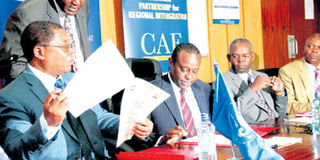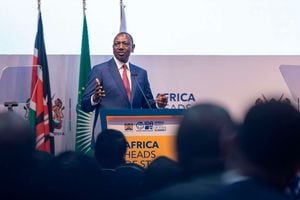Central Bank holds basic lending rate as shilling takes more beating

Comesa secretary general Sindiso Ngwenya (left), Treasury Cabinet Secretary Henry Rotich (Centre) and PS Kamau Thugge during the signing of Kenya’s Regional Integration Support Mechanism (RISM) allocation grant of Sh190 million between the trade bloc and Kenya financed by the European Union at the Treasury on May 6, 2015. PHOTO | DIANA NGILA | NATION MEDIA GROUP
What you need to know:
- A business survey released on Tuesday by Standard Chartered Bank shows weakening of the shilling as one of the biggest worries of business leaders.
- In any event, MPC noted, the shilling has behaved better compared with other major international and regional currencies against the dollar.
- An April report by Renaissance Capital warned that the local currency could weaken to 97.5 units against the US dollar before the end of the year, a prediction that is coming to pass at a much faster rate.
The Central Bank advisory team on Wednesday retained the key lending rate at 8.5 per cent defying market sentiments of a slight rate rise to cushion the shilling from weakening further against the dollar.
Market players talked to expected the Monetary Policy Committee to raise the benchmark CBR rate by 500 basis points to support the local unit.
“MPC decided to retain the CBR at 8.50 per cent and will continue to monitor any emergent risks from the external and domestic economies that may impact on price stability,” a statement signed by Deputy Governor Haron Sirima read.
Interest rate, inflation and foreign exchange are the three areas that concern CBK.
Yesterday, the shilling extended its losing streak, closing trade at 95.15/95.25 against the dollar, the lowest it has exchanged at in the last three years.
“At this rate, the weakening of the local currency could be alarming. As a longer term solution, it needs to be re-looked at from the perspective of our trade balance which is not in our favour as a country due to a surge in imports against slowdown in exports,” Mr Eric Munywoki, a market analyst at Old Mutual said.
A business survey released on Tuesday by Standard Chartered Bank shows weakening of the shilling as one of the biggest worries of business leaders. They fear that the fall could lead to high prices of imports, which would affect those of inputs and consequently the final pricing of products.
Defending its decision, which some players say risks pushing the shilling to the 2011 trajectory, where it hit 107 to the dollar, the committee argued that the current volatility is largely on three accounts.
“A stronger US dollar in the global currency markets and an enhanced, but seasonal, demand for foreign exchange by the local corporate sector largely associated with dividend and profit remittances.”
The third being an adjustment “to the slight misalignment in line with fundamentals in the economy.”
In any event, MPC noted, the shilling has behaved better compared with other major international and regional currencies against the dollar.
MPC hopes that the $6.9 billion kept by CBK as usable foreign exchange reserves and the precautionary facility with the International Monetary Fund will cushion the foreign exchange market against any temporary shocks.
An April report by Renaissance Capital warned that the local currency could weaken to 97.5 units against the US dollar before the end of the year, a prediction that is coming to pass at a much faster rate.
Tourism, which is a major source of forex inflows for Kenya continues to decline on the back of insecurity concerns perpetrated by the Al-Shabaab militia.
Towards the end of 2011, increased imports put pressure on the shilling and the cost of living, with the local currency weakening to an unprecedented level of 107 units against the dollar.
Inflation in the year rose to 19.72 per cent. This compelled CBK to raise the rate at which it lends to commercial banks to 18 per cent from 7 per cent within the last half of 2011.





